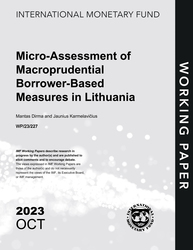
Micro-Assessment of Macroprudential Borrower-Based Measures in Lithuania
Micro-Assessment of Macroprudential Borrower-Based Measures in Lithuania
READ MORE...
Volume/Issue:
Volume 2023
Issue 227
Publication date: October 2023
ISBN: 9798400256578
$20.00
Add to Cart by clicking price of the language and format you'd like to purchase
Available Languages and Formats
| English |
Prices in red indicate formats that are not yet available but are forthcoming.
Topics covered in this book
This title contains information about the following subjects.
Click on a subject if you would like to see other titles with the same subjects.
Banks and Banking , Economics- Macroeconomics , Economics / General , macroprudential policy , borrower-based measures , LTV , mortgage credit risk , lifetime expected loss , probability of default , , calibration exercise , BBM package , modeling mortgage risk , Lithuania's housing market , Mortgages , Loans , Credit risk , Housing prices , Macroprudential policy instruments , Europe , Baltics , Global
Also of interest
Summary
Despite having introduced borrower-based measures (BBM), Lithuania's housing and mortgage markets were booming during the low-interest-rate period, casting doubt on the macroprudential toolkit's ability to contain excessive mortgage growth. This paper assesses the adequacy of BBMs’ parametrization in Lithuania. We do so by building a novel lifetime expected credit loss framework that is founded on actual loan-level default and household income data. We show that the BBM package effectively contains mortgage credit risk and that housing loans are more resilient to stress than in the preregulatory era. Our BBM limit calibration exercise reveals that (1) in the low-rate environment, income-based measures could have been tighter; and (2) borrowers taking out secondary mortgages rightly are and should be required to pledge a higher down payment.
Copyright © 2010 - 2026
Powered by:
AIDC



